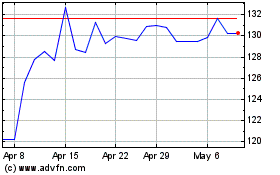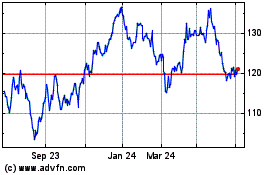Rio Tinto Says 2Q Iron-Ore Exports Up, But Cautions on Economic Outlook -- Update
15 July 2022 - 10:14AM
Dow Jones News
By Rhiannon Hoyle
Rio Tinto PLC on Friday sounded a cautious note on the global
economic outlook, even as it reported a lift in shipments of its
flagship product iron ore, the main ingredient in steel.
The Anglo-Australian mining company highlighted concerns about a
growing risk of a recession, and said the trade disruptions, food
protectionism and energy crisis squeezing supply chains will need
to ease significantly before inflation pressures subside.
"The economic outlook is weakening due to the Russia-Ukraine
war, tighter monetary policy to curb rising inflation, and targeted
Covid-19 restrictions in China," said Rio Tinto, the world's second
largest mining company.
Higher rates of inflation have increased the miner's closure
liabilities, it said. Rio Tinto estimated a roughly US$400 million
pretax hit to underlying earnings in its first fiscal half.
Faced with falling commodity prices, Chief Executive Jakob
Stausholm sought to reassure investors on the miner's strategy.
"We are determined to further strengthen Rio Tinto while
investing to grow in the commodities needed for the energy
transition, decarbonize our portfolio, be a partner and employer of
choice, maintain our tight capital allocation and continue to pay
attractive dividends," he said.
The company on Friday said it produced more iron ore and copper
in its fiscal second quarter versus a year earlier, but downgraded
full-year goals for aluminum and diamond output.
It reported shipments of 79.9 million metric tons from its
mammoth iron-ore operations in Australia's Pilbara during the three
months through June, up 5% on a year ago. Alongside Brazil's Vale
SA, Rio Tinto is the world's top producer of the steel
ingredient.
Its full-year estimate for Australian iron-ore shipments is
unchanged, at 320 million-335 million tons, although Rio Tinto
cautioned on potential impacts from the Covid-19 pandemic. It also
said guidance is dependent on a smooth ramp-up of its new
Gudai-Darri operation and the availability of skilled labor, as
worker shortages challenge the industry.
The miner also recorded a 9% year-on-year rise in second-quarter
mined copper output, to 126,000 tons, and a 3% increase in bauxite
production, to 14.1 million tons.
However, second-quarter aluminum output tumbled by 10%, to
731,000 tons, after a labor strike reduced capacity at its Kitimat
smelter in British Columbia. "A controlled restart began at the end
of the second quarter of 2022, with ramp-up progressing subject to
plant stability," the miner said.
Production at the Boyne smelter in Australia's Queensland state
was impacted by Covid-19-related absenteeism.
Rio Tinto cut its fiscal-year aluminum production goal to 3.0
million-3.1 million tons, from 3.1 million-3.2 million previously.
It pared its alumina guidance to 7.6 million-7.8 million tons, from
8.0 million-8.4 million.
The miner also reduced its full-year diamonds production
estimate to 4.5 million-5.0 million carats, from 5.0 million-6.0
million. A build up of maintenance and impacts from the Covid-19
pandemic impacted performance during the half, it said.
Rio Tinto said it continues to negotiate the restart of work at
the Simandou iron ore project in Guinea. The military junta in
Guinea Conakry has suspended Rio Tinto and the Winning Consortium
Simandou from mining activities on the iron-ore deposit after a
deadline to create a joint venture was missed.
Rio Tinto is also "continuing to explore all options" for its
Jadar lithium project in Serbia. Officials in January revoked Rio
Tinto's licenses for the project following community protests over
environmental concerns.
Write to Rhiannon Hoyle at rhiannon.hoyle@wsj.com
(END) Dow Jones Newswires
July 14, 2022 19:59 ET (23:59 GMT)
Copyright (c) 2022 Dow Jones & Company, Inc.
Rio Tinto (ASX:RIO)
Historical Stock Chart
From Mar 2024 to Apr 2024

Rio Tinto (ASX:RIO)
Historical Stock Chart
From Apr 2023 to Apr 2024
